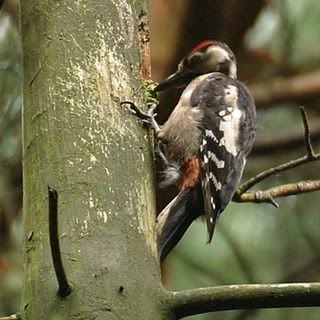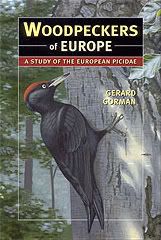 Both juvenile Great Spotted Woodpeckers (male and female) have complete red crowns with black borders at the sides. This immediately separates them from adults. Black areas are matt, not glossy, and often rather brown. There may be some dark barring on the white scapular ovals. Juveniles also have a weaker black malar stripe than adults and the post-auricular stripe is narrower and often does not quite reach the nape. Overall, white areas, particularly the cheeks, are greyer than on adult birds. Some grey streaks, occasionally light bars, cover the sides of the breast and flanks. The ventral area is pinkish, not as strong red (scarlet) as on adults. Some juveniles show a faint dark band across the chest and, more rarely, a flush of pink. The iris is brown, not as red as in adults. Juvenile males have a larger, brighter red crown than juvenile females. The black border to the red crown is also less extensive than on females. Juvenile males show the first signs of the sexually diagnostic red nape patch after the first moult at the end of summer into autumn. Juvenile females, unlike adult females, have red on the crown. This area of red is, however, smaller than on juvenile males and thus the black border is broader. The under-tail coverts are pink and less extensive than on juvenile males. The photo above shows a juvenile female in Germany (Thomas Kraft). Note the thick black border to the small red crown patch and the rather dull pink undertail. The post-auricular stripe is rather weak where it joins the nape and indeed seems to be broken: this is common in juveniles.
Both juvenile Great Spotted Woodpeckers (male and female) have complete red crowns with black borders at the sides. This immediately separates them from adults. Black areas are matt, not glossy, and often rather brown. There may be some dark barring on the white scapular ovals. Juveniles also have a weaker black malar stripe than adults and the post-auricular stripe is narrower and often does not quite reach the nape. Overall, white areas, particularly the cheeks, are greyer than on adult birds. Some grey streaks, occasionally light bars, cover the sides of the breast and flanks. The ventral area is pinkish, not as strong red (scarlet) as on adults. Some juveniles show a faint dark band across the chest and, more rarely, a flush of pink. The iris is brown, not as red as in adults. Juvenile males have a larger, brighter red crown than juvenile females. The black border to the red crown is also less extensive than on females. Juvenile males show the first signs of the sexually diagnostic red nape patch after the first moult at the end of summer into autumn. Juvenile females, unlike adult females, have red on the crown. This area of red is, however, smaller than on juvenile males and thus the black border is broader. The under-tail coverts are pink and less extensive than on juvenile males. The photo above shows a juvenile female in Germany (Thomas Kraft). Note the thick black border to the small red crown patch and the rather dull pink undertail. The post-auricular stripe is rather weak where it joins the nape and indeed seems to be broken: this is common in juveniles.
Tuesday, 11 September 2007
Great Spotted Woodpecker: juvenile ID
 Both juvenile Great Spotted Woodpeckers (male and female) have complete red crowns with black borders at the sides. This immediately separates them from adults. Black areas are matt, not glossy, and often rather brown. There may be some dark barring on the white scapular ovals. Juveniles also have a weaker black malar stripe than adults and the post-auricular stripe is narrower and often does not quite reach the nape. Overall, white areas, particularly the cheeks, are greyer than on adult birds. Some grey streaks, occasionally light bars, cover the sides of the breast and flanks. The ventral area is pinkish, not as strong red (scarlet) as on adults. Some juveniles show a faint dark band across the chest and, more rarely, a flush of pink. The iris is brown, not as red as in adults. Juvenile males have a larger, brighter red crown than juvenile females. The black border to the red crown is also less extensive than on females. Juvenile males show the first signs of the sexually diagnostic red nape patch after the first moult at the end of summer into autumn. Juvenile females, unlike adult females, have red on the crown. This area of red is, however, smaller than on juvenile males and thus the black border is broader. The under-tail coverts are pink and less extensive than on juvenile males. The photo above shows a juvenile female in Germany (Thomas Kraft). Note the thick black border to the small red crown patch and the rather dull pink undertail. The post-auricular stripe is rather weak where it joins the nape and indeed seems to be broken: this is common in juveniles.
Both juvenile Great Spotted Woodpeckers (male and female) have complete red crowns with black borders at the sides. This immediately separates them from adults. Black areas are matt, not glossy, and often rather brown. There may be some dark barring on the white scapular ovals. Juveniles also have a weaker black malar stripe than adults and the post-auricular stripe is narrower and often does not quite reach the nape. Overall, white areas, particularly the cheeks, are greyer than on adult birds. Some grey streaks, occasionally light bars, cover the sides of the breast and flanks. The ventral area is pinkish, not as strong red (scarlet) as on adults. Some juveniles show a faint dark band across the chest and, more rarely, a flush of pink. The iris is brown, not as red as in adults. Juvenile males have a larger, brighter red crown than juvenile females. The black border to the red crown is also less extensive than on females. Juvenile males show the first signs of the sexually diagnostic red nape patch after the first moult at the end of summer into autumn. Juvenile females, unlike adult females, have red on the crown. This area of red is, however, smaller than on juvenile males and thus the black border is broader. The under-tail coverts are pink and less extensive than on juvenile males. The photo above shows a juvenile female in Germany (Thomas Kraft). Note the thick black border to the small red crown patch and the rather dull pink undertail. The post-auricular stripe is rather weak where it joins the nape and indeed seems to be broken: this is common in juveniles.
Subscribe to:
Post Comments (Atom)





No comments:
Post a Comment